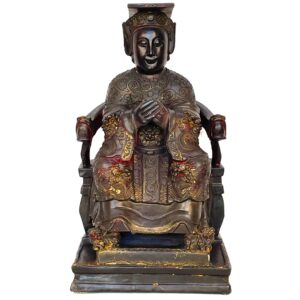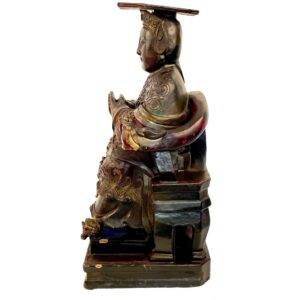-


$275.00
This small antique-Chinese-wood-carving represents Mazu, which translates as “Mother Ancestor,” the tutelary deity “Protector of the Sea” who protects seafarers and is very popular among Taiwanese, Fujianese, and Cantonese sea cultures. This syncretic cult figure is the most imortant ofthe female Taoist-Deities and continues to be worshipped by Taoist, Buddhist and Popular Religion followers. In…
-


$775.00
Tudi Gong is the Chinese Earth or Land God referred to by many names and often fondly referred to by commoners as “Grandpa.” He is a syncretic deity and tutelary deity, responsible for administrating and protecting the affairs of small towns and villages, especially issues concerning agriculture or wealth, and is believed to control the…
-


$595.00
Statues of attendants often appear as a pair looking inward and flanking a deity, unless they are very important ones and look straight ahead. They may carry a range of offerings. This antique Chinese woodcarving appears to be a Taoist image likely placed on a home altar along with deities, house gods and ancestors to…
-
Sale!


$1,050.00 Original price was: $1,050.00.$650.00Current price is: $650.00.
H: 15.375” W: 8.625” D: 7.5” | CONTACT US AT 213-568-3030 or email [email protected] for SHIPPING.
Mazu, protector of sea, is portrayed as the imperially sanctioned “Empress of Heaven” on an elaborate, horseshoe shaped dragon throne, holding a hu tablet, with elegant dragon robes, official’s girdle, Empress headdress and small feet on gilt fu lion foot rest.
-


$795.00
This fine antique Chinese wood carving was likely placed in a clan shrine or home altar with other religious images, ancestor figures or folk heroes reflecting the Chinese syncretic tradition that adhered to multiple spiritual and belief systems. Although it is difficult to identify specific figures, this image is likely a Taoist priest in officials…
End of content
End of content










